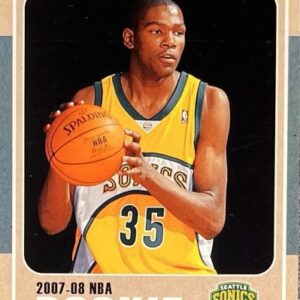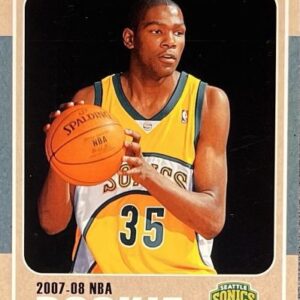Envision yourself wading through the wares of a bustling card convention where vintage vibes meet contemporary cravings. Amidst the myriad choices, there’s one card that seems to have donned a cloak of invincibility—the 2003 Topps LeBron James rookie card, number 221. It stands as a testament to both time and taste, bridging the gap between different collecting eras like a savvy diplomat of cardboard collectibles. This artifact undoubtedly commands attention, emerging repeatedly in conversations as the go-to option for both novice collectors and seasoned aficionados alike.
What is it about this piece of card magic that keeps it firmly anchored in the center of the hobby universe while other cards drift away like forgotten shooting stars? It’s not just about flashiness or scarcity, although the hobby offers those aplenty. The 2003 Topps base card is the very definition of cornerstone—a card that has educated entire generations on what collecting is truly about. Its blend of accessible supply and high demand offers collectors a realistic chase, mixing tantalizing excitement with achievable dreams.
A glance at market behavior solidifies its revered status. As recently as mid-August 2025, eBay auctions for PSA 10 graded cards hovered like clockwork around the two-thousand-dollar mark, occasionally spiking when bidding wars broke out. This kind of consistent pricing signals a card that commands respect without being volatile. On platforms like Card Ladder, an upward trend in late August saw prices breaching the two-thousand-five-hundred-dollar barrier. It wasn’t wild speculation; it was just steady, confident growth underpinned by genuine interest—a rare trait in the dizzying peaks and valleys of card markets.
But the Topps lineage doesn’t halt at the base card. A family of intriguing relatives includes the Black Border, historically leaning towards the dramatic, capped at five hundred copies; the elusive Gold variant, limited to a mere ninety-nine pieces; and the First Edition stamp, offering a touch of scarcity without diving headfirst into serial-numbered triple-digit territory. Together, these cards dance off checklists and price tools, staples for those yearning for a touch more complexity in their collections.
Among these siblings is the Topps Collection photo variation—an amiable oddball with its unique imagery. While it usually trails behind its more noted relatives in gem mint condition, it appeals to set builders taking the scenic route down memory lane.
Grading, of course, plays a pivotal role in the card’s journey. The PSA 10 population remains quite robust, ensuring the card behaves like a blue-chip stock rather than a wispy specter of rumor. Yet, even in this realm of uniformity, a spread exists, separating PSA 9s from their perfect-score brethren not just in dollar terms, but in perceived value. Raw versions entice with their more approachable price range, often between $250 and $300, and for those graded a PSA 9, the tag remains comfortably in the $400 zone. Here, the devil is in the details like centering and surface quality, elevating clear photos and seller credibility over sheer collecting zeal.
Month by month, if you’re living via price comps, this is your guidebook: track evening eBay auctions for PSA 10s, watch most settle near those two-thousand-dollar realms, and occasionally, witness peaks when bidding becomes a determined duel. It’s a card that invites scrutiny, where deep liquidity ensures no shortage of curious eyes fixating on price and condition factors.
And then, always lingering, is the enduring debate of paper versus chrome, an argument as perennial as the flowers waiting for spring rain. While chrome refractors boast vivid peacock blends, the paper Topps base remains a tangible piece of nostalgic essence, rooted deeply in the memories of binders and starter stacks from the mid-2000s. If choices must be made, the paper tells the nuanced tale of a hobby transitioning between epochs, as summarized by experts like those at Cardboard Connection.
The card’s true joy lies in its accessibility across budget lines. Clutch a strong PSA 9 for half of a gem mint’s price, or opt for the project of a well-centered raw card to nurture or perhaps resubmit for grading. For those imbued with a passion for rarity, the First Edition offers a taste of exclusivity without the lofty Black and Gold premiums, mixing challenge with satisfaction.
Then there’s that wild card chance. Imagine rending Galaxy Rip Packs to unearth a 2003 Topps LeBron. Despite any skepticism, the curated chase moments promise genuine thrill without devolving into fanciful daydreaming—a delightful testament to why collectors and enthusiasts ripping wax is an exhilarating hobby cornerstone.
By 2025, the legend of this card needs no additional fanfare. Its reputation has solidified, inviting collectors to explore a checklist, sip the intoxicating aroma of recent bids, and ponder the many satisfied collectors it unites. Whether yearning to safeguard one long-term, targeting the elusive beauty post-show, or opting to conquer the odds through a tantalizing rip, the 2003 Topps LeBron is undeniably a steadfast treasure amidst a constellation of collectibles—and its gravitational pull remains a comforting constant, drawing the hobby community into its magnetic embrace.






